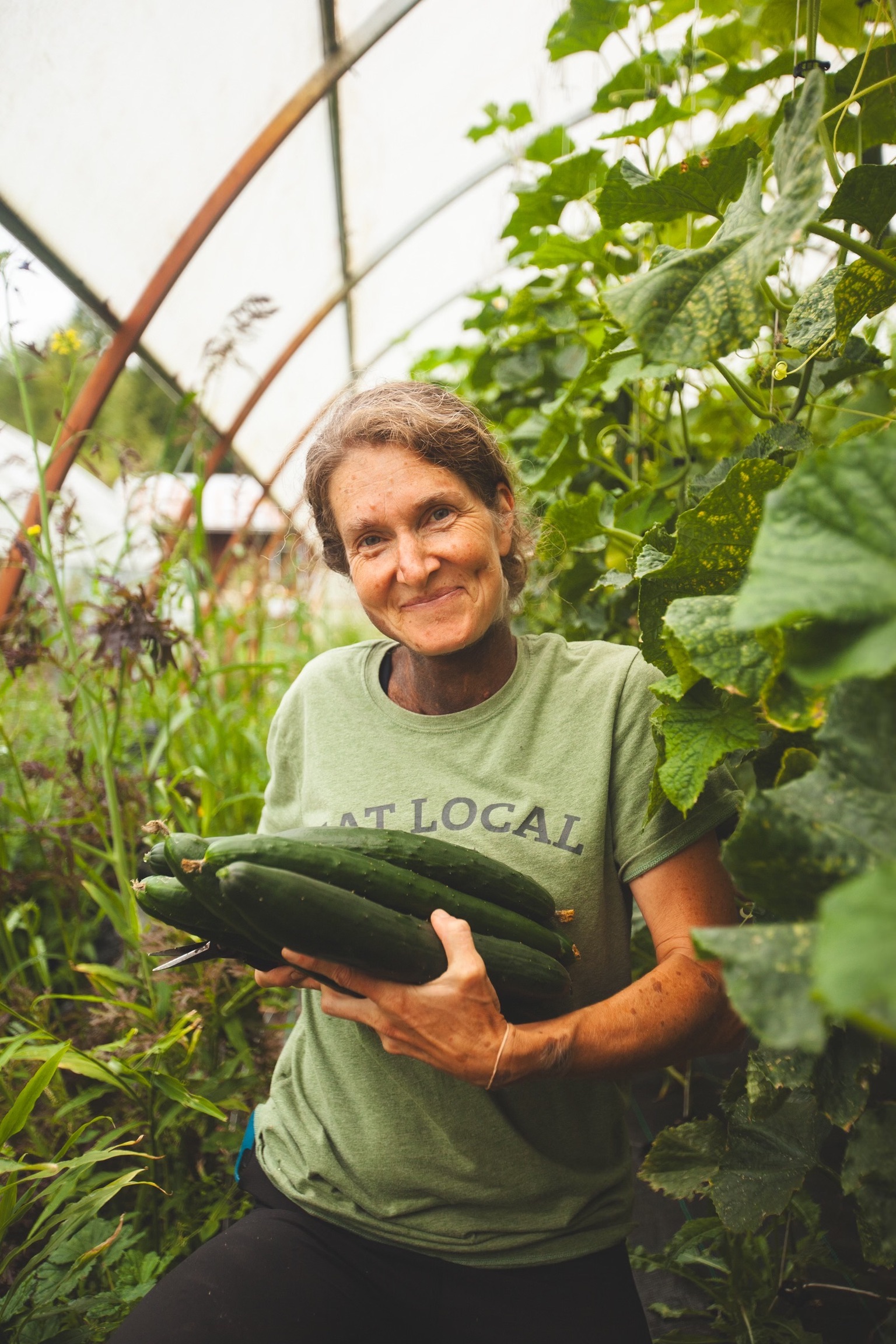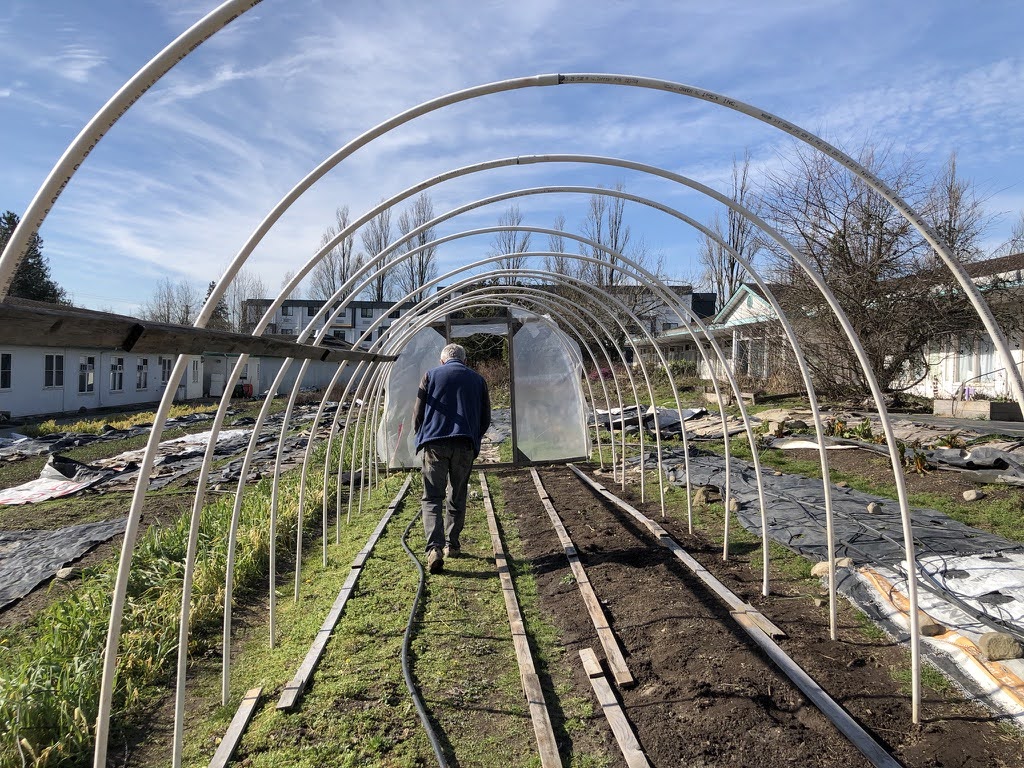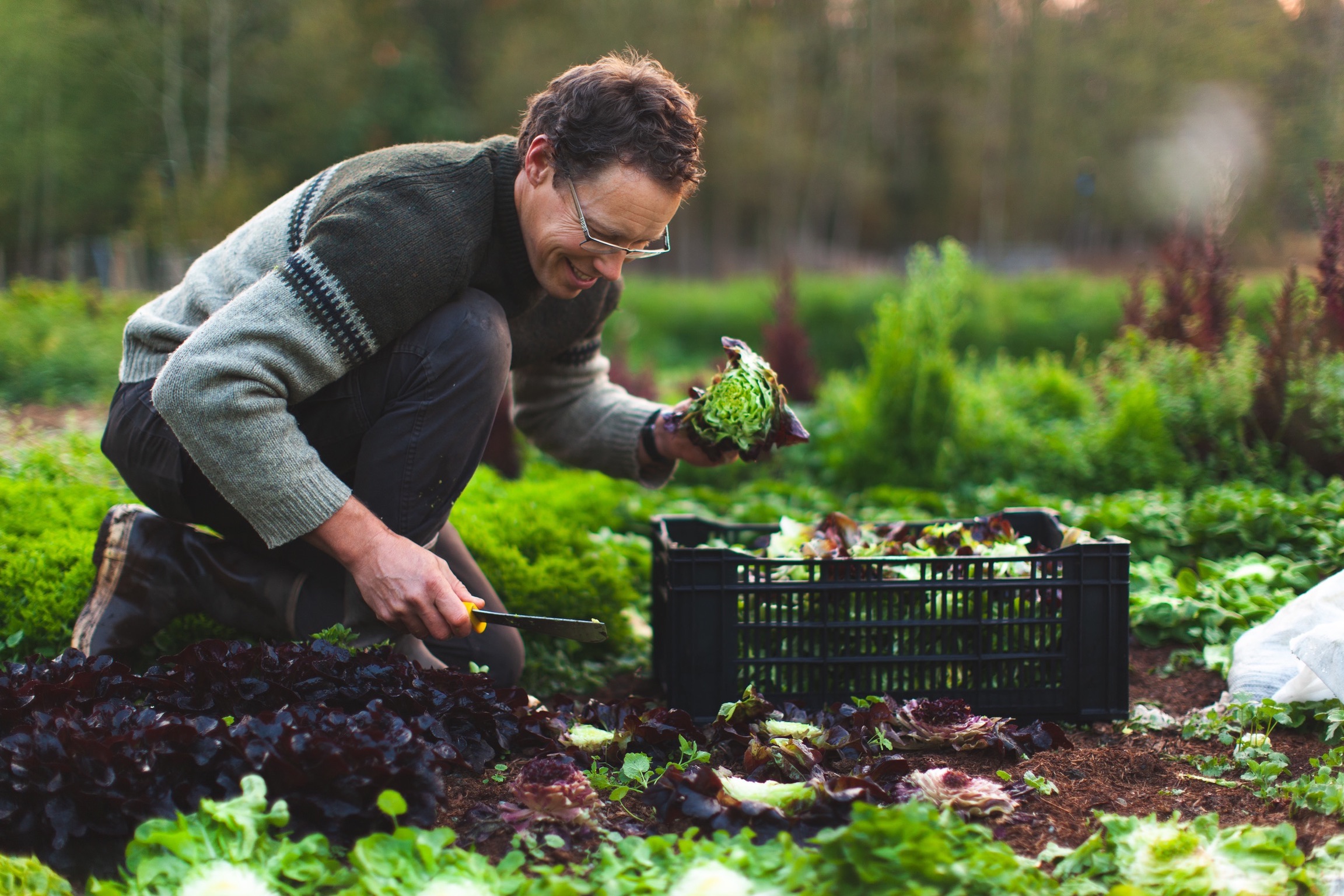In his straw hat and rubber boots, Paul Neufeld ambles over to the cabbage beds, cupping a young cauliflower head in his palm. “Look what I found,” he says with a smile, offering me a bite. It’s crisp and fresh, exactly what you’d expect from produce grown sustainably in fertile soil just steps from where we’re standing.
Paul and his wife, Angela, own and run Kingfisher Farm Market on a small but densely planted acre of land in South Surrey, just a few blocks from the U.S. border. Here, fluffy dill fronds wave next to colourful swiss chard, while carrots nestle on either side of the zucchini. Over the course of the season, more than 500 varieties of crops will be planted, from broccolini and kale to kohlrabi, tomatoes, and turnips. “We’re trying to make as much use of our small, limited space as we can,” Paul says.
Unlike the larger-scale, mechanized farms nearby, the Neufelds sell their produce directly to their community, rather than to wholesalers who ship to supermarkets in bulk. “We’re cultivating, growing a community that is connected to where their food is grown,” Angela says.
After studying international development and especially how it pertains to agriculture in developing countries, Paul felt the need to focus on Canada, to take responsibility for what we grow, consume, and discard here. Our world is not limitless in its resources so we have to live within its limits, he says. In his 20s, he longed to live simply off the land, growing and mindfully consuming his own food. That vision soon expanded to nourishing the community around him, as well.
Over the past few decades many people have gravitated toward wanting to know where their food comes from, to be more in touch with the people who nourish them, he notes.
About an hour northwest of the Neufelds’ land, Chris Bodnar’s family farm, Close to Home Organics, works cooperatively with several others to cultivate and manage 50 acres on the banks of the Fraser River in Abbotsford, at Glen Valley Organic Farm.
Related stories
- A Vancouver Nonprofit Strengthens Communities Through Urban Farming
- Volunteers at Vancouver’s Fruit Tree Project Harvest the City’s Backyard Bounty
- Reducing Waste and Want With Vancouver Food Runners
Growing fresh produce locally to feed our own communities is important for so many reasons, Bodnar says. “We’re seeing that right now, where people are looking at how much of our produce comes from the U.S. and what happens if our food becomes the subject of a trade war, for example.”
But beyond politics and international supply chains, preserving local farmland plays a critical role in sustaining healthy societies. “Farms steward not just the land that we farm on, but we steward the waterways that flow through. We steward the aquifers underneath the land that provide water. The more land we pave over, the less our aquifers are able to recharge—that has a social impact beyond simply one farm,” Bodnar says. It affects our whole ecosystem. “So understanding how all of those pieces fit together is part of having an integrated society, where we may have urban centres, but we have food-producing areas that support those centres.”

Cucumber harvest at Kingfisher Farm. Photo by Whitney Buckner.
Bodnar has 520 members—from Langley to North Vancouver—signed up for Close to Home’s community-shared agriculture (CSA) program this season. “We have a community that values very much having local, organic agricultural production,” he says.
In exchange for an upfront payment prior to the farming season or several instalments throughout, members purchase a share of the harvest and pick up a box bursting with fresh produce every week from June to November. For members, it’s a way to sustain local agriculture and know exactly where their food is coming from. In return, the farm gets the capital it needs to finance each season’s startup costs, from seeds and other supplies to costly operational expenses.
It’s a business model that works for his small-scale, family farm, Bodnar says. It seems to work for his CSA members too, some of whom have been with him for 16 years. “We’ve watched their children grow up. They’ve watched our children grow up.”
Leaa Both is newer to community-supported agriculture and farming in general but no less committed to nourishing neighbours. We meet on a drizzly afternoon in mid-May under the big spruce tree that doubles as Farmers on 57th’s office. Both immediately takes me on a tour of the nonprofit organization’s half-acre of farmland tucked discreetly off Heather Street on the lawn of the old Oak Care Centre.
Running along the gentle slopes between the long-term care facility’s squat 1950s residences are more than 40 crop beds, transforming once underused institutional lawns into a bountiful urban community farm.
“People hear that we’re off Cambie Street, and they’re amazed,” says Both, who coordinates Farmers on 57th’s programs. “We get people walking by all the time that had no idea there was a farm here.”
On this day, eight rows of Coastal Star romaine lettuce heads are poking their early leaves above the soil. Their cousin, the Freckles lettuce, hails from two rows over, their new leaves an attractive red-speckled green. Garlic stalks already stand two feet tall. “Our members really love the garlic,” Both notes. “It’s really strong and juicy when it’s fresh.”
This season, 55 members have subscribed to Farmers on 57th’s CSA program. The organization also offers community garden plots, a course on how to grow your own food, therapeutic gardening sessions with accessible beds for the care centre’s residents, and an off-site planting program for newcomers and refugees in conjunction with South Vancouver Family Place and Neighbourhood House. “Community is at the centre of everything we do,” Both says.

Early-season soil preparation at Farmers on 57th.
Ann-Marie Metten has been subscribing to Farmers on 57th’s CSA program since its inception 15 years ago. She was taken with the opportunity to buy local, to convert resource-wasting lawns into food production, and to support the creation of a community gathering hub in the heart of Marpole. Now she describes the farm as a magical place in her neighbourhood, one that simply can’t compare to a supermarket experience. She looks forward to her weekly visits to pick up her produce.
“You come, and you’re greeted by name, and everything is hand-presented to you,” she says. “And then you can wander through the veggie rows and watch the bees pollinate, and there’s children there and all kinds of neighbours of all backgrounds. It’s a beautiful part of my week.”
For Both, digging in the dirt and working side by side with staff and volunteers to grow fresh food for the surrounding community is deeply satisfying. Angela Neufeld agrees. Back at Kingfisher Farm Market in South Surrey, she loves it when kids run up to her calling, “Farmer Angela!” and their parents say, “They tried something they would never have eaten because they knew that you grew it.”
Despite the financial security of the CSA subscription model, Angela and her husband, Paul, have shifted away from prepaid harvest boxes to focus primarily on selling their fresh produce at their roadside stall and weekly market, which they run Tuesdays out of a 1928 heritage barn on the property. “I like the buzz of the market,” Angela explains. “There is an energy of market, which is not the same for CSA pickup.” According to Angela, Kingfisher’s market draws about 600 to 700 customers weekly, many of whom live within walking distance of the farm.
Magdalen Bowyer lives less than a block away and never misses a Tuesday market. She can’t say enough about the Neufelds, their farm, and the sense of community they instil in the neighbourhood. “Every time I walk into that barn, they create so much beauty—not just with the produce, but with the presentation of it and the stories that they bring about what they’re growing and why they’re growing it.”
Bowyer says she rarely goes to a grocery store from June to November. She feels a personal connection to Paul and Angela and the produce they cultivate, a relationship that’s absent in the aisles of a supermarket.
“They see themselves as stewards—stewards of the land, stewards of the community—and you can taste that,” she says. “I can taste that.”
Read more community stories.









